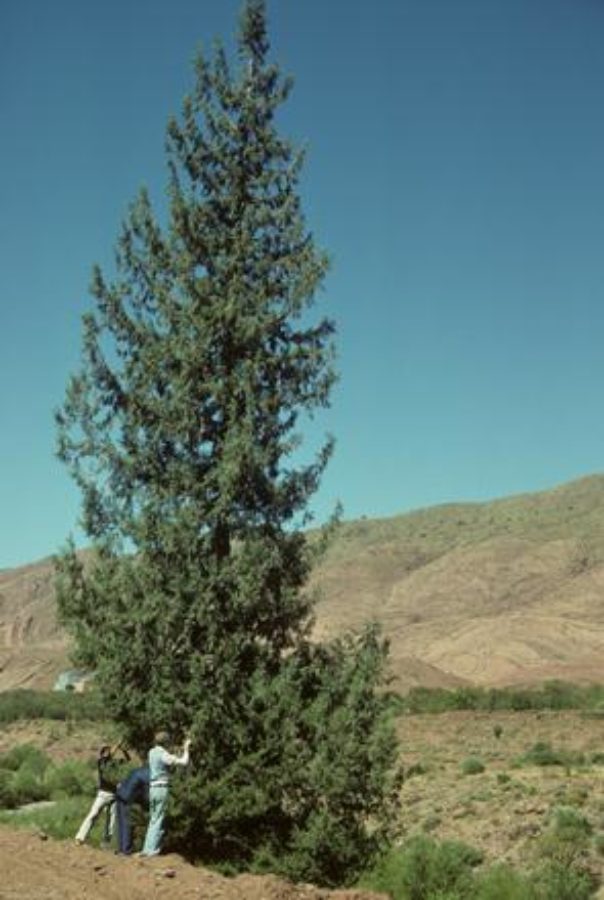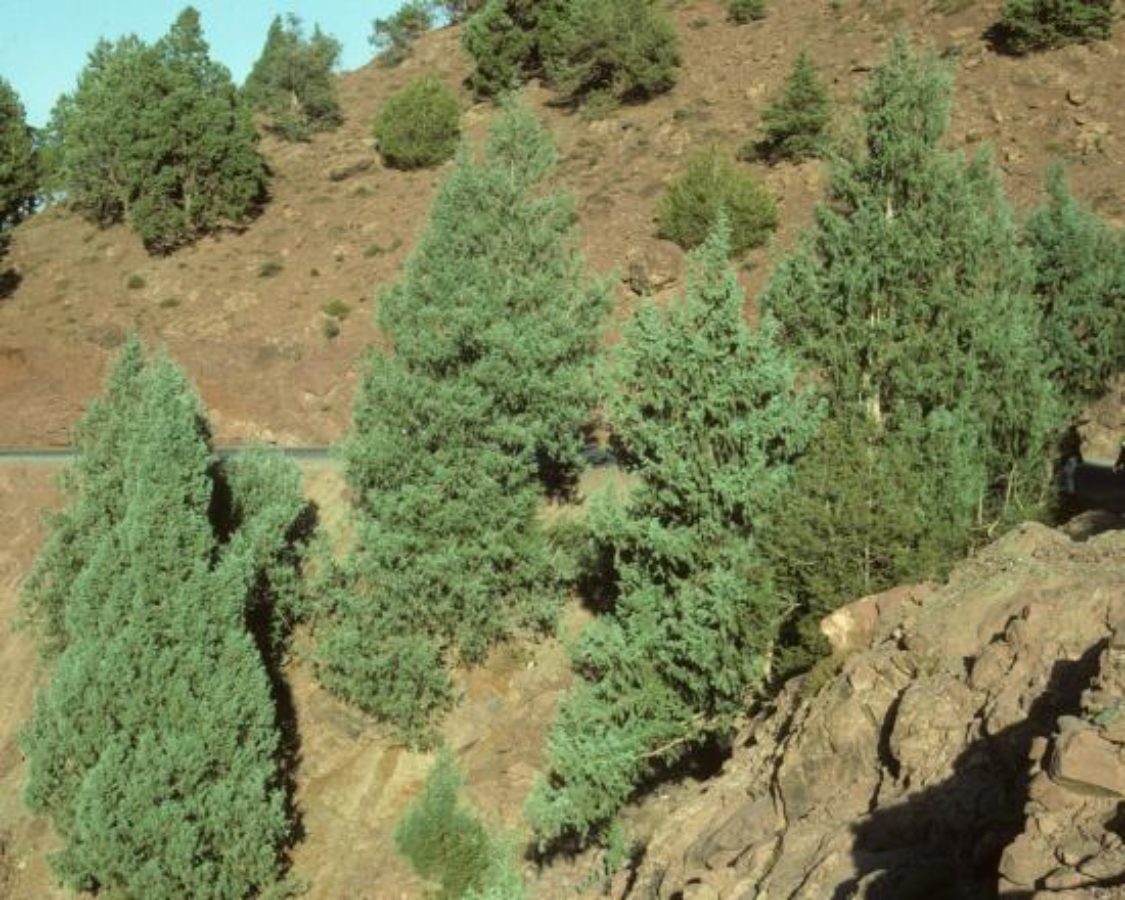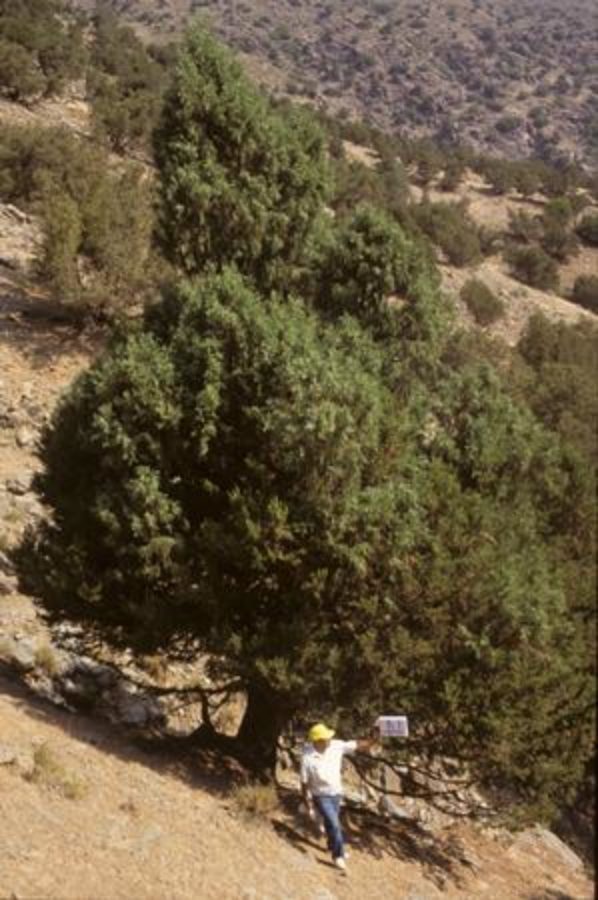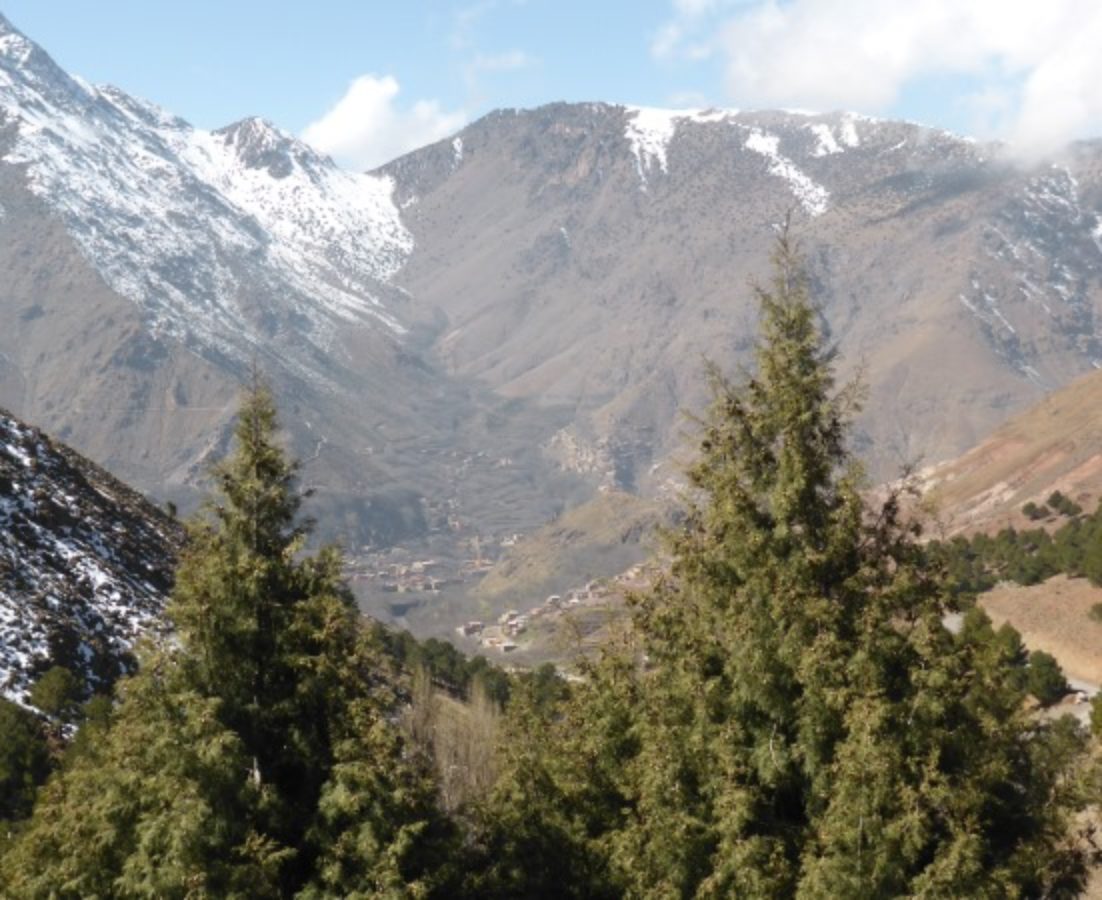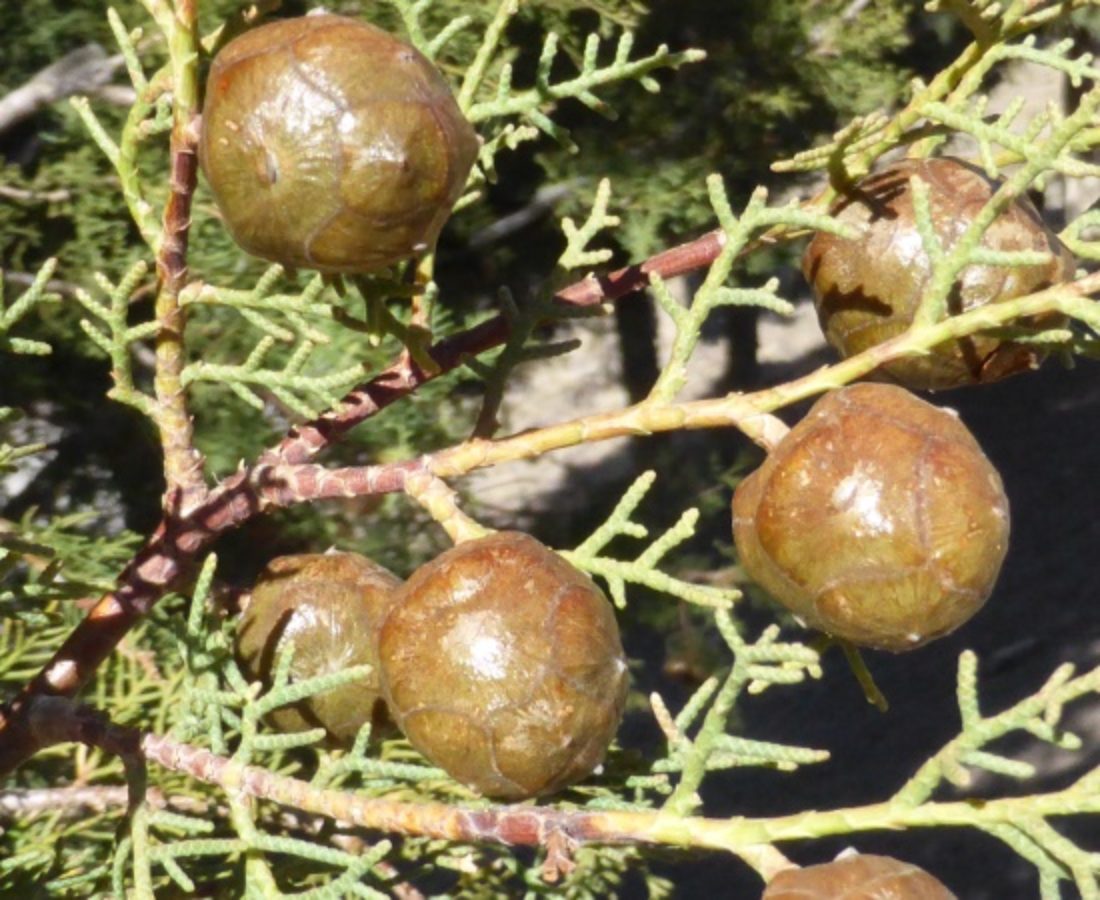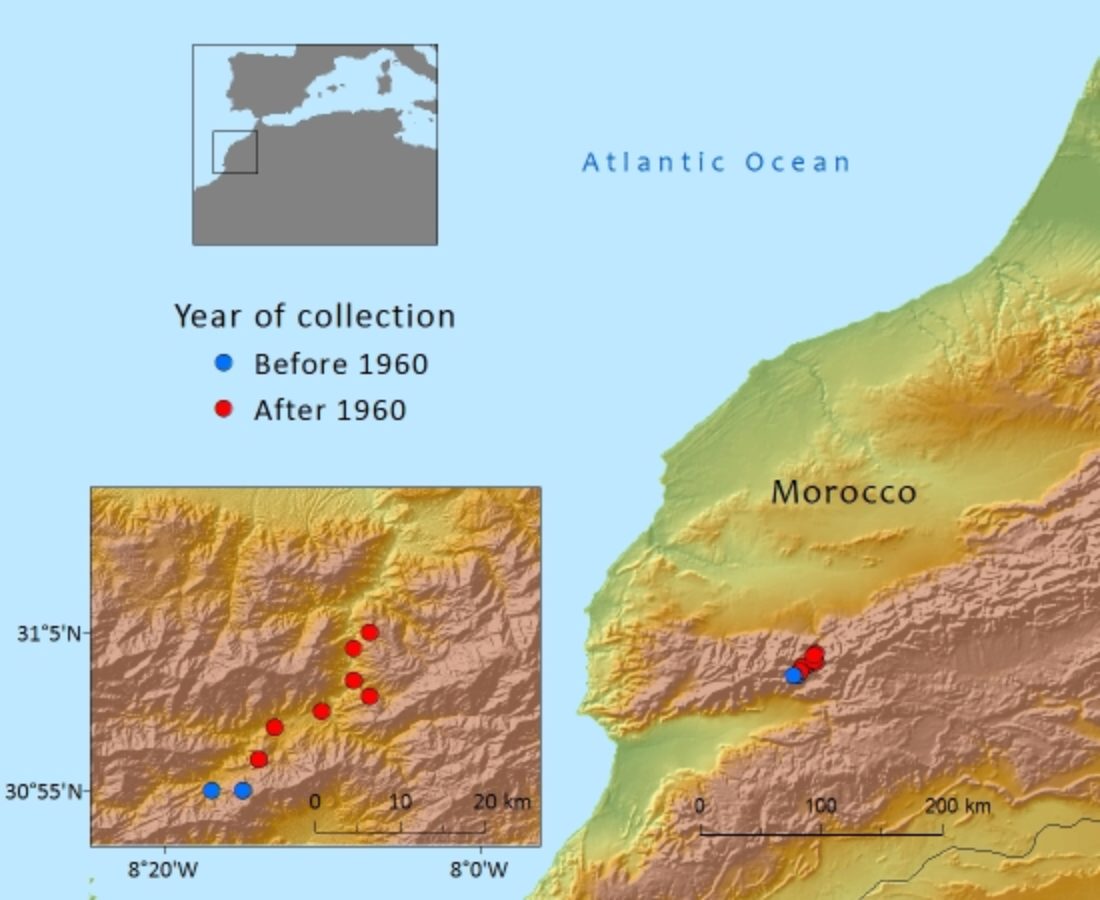Cupressaceae
Cupressus dupreziana var. atlantica
One of two varieties of cypress native to North Africa where it occurs in a very restricted area of the Atlas Mountains of Morocco. The severely fragmented population is Critically Endangered
Description
Habit
Tree 16–18m tall, monoecious; trunk d.b.h. 2–3m. Bark thick, deeply fissured, exfoliating in longitudinal strips. Branches spreading or ascending, forming a conical or pyramidal tree
Foliage
Spreading or drooping to pendulous. Leaves, scale-like (all equal in size), arranged in opposite pairs at right angles to those above or below, overlapping, gradually tapering, with glands, stomata few and scattered on margins near leaf base; shiny greyish-green or glaucous green.
Cones
Male pollen-cones on branches close to female cones, solitary, terminal, ovoid, 4–6 x 2–3mm, yellowish-brown when mature. Female seed-cones solitary on lateral branches, terminal on short leafy branchlets, ovoid-oblong, 15–27 x 13–21mm, light brown when mature; bract-scale complexes 10–12 in opposite pairs at right angles to those above or below. Seeds 6–8mm, closely packed, ovoid-globose, more or less angular, flattened, dark brown, wings 2 on opposite sides, 1–2mm wide.
Notes
The differences between C. dupreziana var dupreziana and C. dupreziana var. atlantica are that the former taxon has ovoid-oblong seed cones with ca 12 bract-scale complexes and the seeds are not angular.
This variety has previously been described as a separate species – C. atlantica (Gaussen, 1950) but both Farjon (2005) and Silba (1998) consider it to be morphologically very close to C. dupreziana. Likewise, from both the morphological and phytochemical studies (Griffiths,1998) it is thought that Cupressus atlantica is a subspecies of C. dupreziana (and very separate from C. sempervirens). Recent research (Rushforth, et al, 2003; Sekiewicz et al. 2016) suggests that C. atlantica should be considered as a distinct species from C. sempervirens and C. dupreziana. However more molecular work is required to confirm its true taxonomic status.
Human Uses
Historically, the wood was utilized for making joists and beams in order to build houses and in the building of large gates for the entrances of old town walls (Bellefontaine, 1979; Achhal, 1986). The larger branches of the trees were utilized to make chairs and tables and other furniture and the smaller branches were collected during the summer and stored for winter feed for the local Berber herds of goats and donkeys. Today substantial amounts of seeds are collected annually for commercial horticulture
References and further reading
- Achhal, A. (1986.) Etude phytosociologique et dendrometrique des écosystèmes forestière du Bassin versant du N’Fiss (Haut Atlas central). Ph.D. Université de droit d’economie et des Sciences d’Aix Marseille: France
- Bechir, A., El Mousadik, A. & Pichot C. (2004). Allozyme diversity of natural and introduced cypress stands in Morocco: consequences for management of genetic resources. Annals of Forest Science. 61(7): 669-676.
- Bellefontaine, R. (1979). Vigeur de croissance du cyprès d’Atlas dans son aire naturelle et dans son aire d’introduction au Maroc. Ann. Rech. Forest. 19: 235-273.
- Boudy, P. (1950). Economie forestière nord-africaine. Monographie et traitment des essences forestières. 2: 764-771. Paris : Editions Larose.
- Farjon A. (2005). A monograph of Cupressaceae and Sciadopitys. Royal Botanic Gardens, Kew. pp. 643
- Gardner, M. & Griffiths, A. (2013). Cupressus dupreziana var. atlantica. In: IUCN 2013. IUCN Red List of Threatened Species. Version 2013.1. <www.iucnredlist.org>. Downloaded on 05 July 2013.
- Griffiths, A. J. K. (1998). Taxonomic and conservation status of Cupressus atlantica. Reading. Unpublished PhD Thesis, University of Reading.
- Rushforth, K., Adams, R. P., Zhong, M., X.-Giang Ma & Pandey, R. N. (2003). Variation among Cupressus species from the eastern hemisphere based on Random Amplified Polymorphic DNAs (RAPDs). Biochemical Systematics and Ecology. 31:17–24
- Silba, J. (1998). A monograph of the genus Cupressus L. J. Int. Conifer Preserv. Soc. 5 (2): 1-98
- Sekiewicz, K., M. Sekiewicz, A. Romo, Y. Didukh, M. Fennane & A. Boratynski (2014). Chorological and conservation status of the endemic cypress, Cupressus atlantica Gaussen, in the High Atlas (Morocco). Dendrobiology 71:3-13.
- Sekiewicz, K., K. Boratynska, M.B. Dagher-Kharrat, T. Ok, A. Boratynski (2016). Taxonomic differentiation of Cupressus sempervirens and C. atlantica based on morphometric evidence. Systematics and Biodiversity:DOI:10.1080/14772000.2016.1171260.
- Stewart, P. J. (1986). Cupressus atlantica. In: FAO Forestry Department (compiler). Databook on endangered tree and shrub species and their provenances. Rome: FAO. 524 pp.
- Xenopoulos, S., Andreoli, C., Panconesi, A., Pinto Ganhao, J. & Tuset, J. J. [date unkn.] Importance of Cypress, pp 1-14 in J. Ponchet (ed.), AGRIMED research programme. Progress in EEC research on cypress diseases. Results of the Agrimed project (1980-1988). Luxembourg: Commision of the European Communities.
- Yani, A., Baradat, P. & Bernard-Dagan, C. (1990). II. Chemotaxonomy of Cupressus species, pp 29-38 in J. Ponchet (ed.), AGRIMED research programme. Progress in EEC research on cypress diseases. Results of the Agrimed project (1980-1988). Luxembourg: Commision of the European Communities
